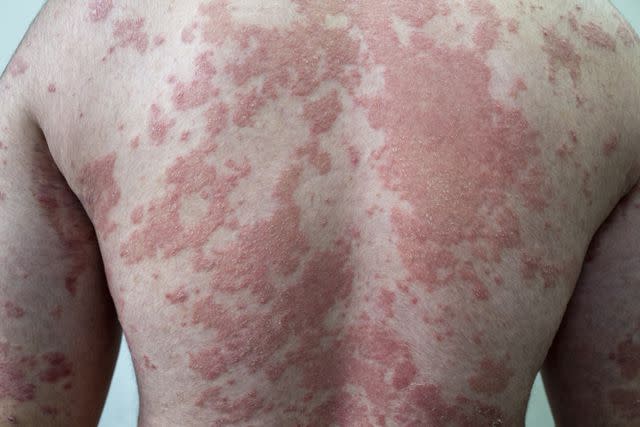Dealing With Psoriasis on Your Back
Psoriasis is a common, chronic autoimmune disorder that prompts skin cells to multiply more rapidly than usual. This causes swollen, scaly patches to develop on your skin. Psoriasis symptoms can crop up anywhere on your body, including your back. Typically, having these patches on your back (especially your lower back) indicates that you have plaque psoriasis—the most common type, which makes up 80–90% of all psoriasis cases.
Learn more about psoriasis on your back, including symptoms, possible triggers, self-care, treatment options, how to find relief, and more.

HengDao / Getty Images
Symptoms: What Psoriasis on Your Back Looks Like
Plaque psoriasis symptoms often appear on the lower back and may extend downward to the upper part of the buttocks. They also often occur on the knees, elbows, and scalp.
Psoriasis symptoms include:
Dry, thickened, and raised patches of skin that may be red, purple, or gray and covered with silvery scales
Itchiness
Pain
Bleeding
Cracking
Flaking and peeling
Nail changes
Psoriasis in Nearby Areas
Depending on your psoriasis type, symptoms can appear on nearly any part of your body. In addition to your back, psoriasis patches may appear on the front or back of your neck, scalp, head, ankles, legs, hands, feet, elbows, knees, torso, and more. In some cases, you may develop symptoms between your breasts, on your groin, or in your armpits.
What Triggers Back Psoriasis Flares?
Psoriasis symptoms often appear during temporary “flare-ups,” which can last anywhere from weeks to months. Then, they may go dormant for quite a while until something triggers them again.
Flare-ups of psoriasis symptoms have many possible triggers, including:
Stress
Certain medications
Excessive alcohol use
Skin injuries, such as bites, rashes, scrapes, and cuts
Getting a piercing or tattoo
Smoking
Fluctuating weather
Dry environments
Cold or hot temperatures
Infections
Naturally, a psoriasis flare-up on your back is more likely to occur if you experience some kind of skin trauma there. For example, getting a sunburn on your back could prompt a flare-up in the same area.
How to Manage Psoriasis on Your Back
Psoriasis isn’t currently curable. However, it can be effectively treated and managed. You can take steps to manage psoriasis on your back by:
Identifying and avoiding your psoriasis triggers
Moisturizing your skin regularly
Protecting your skin from ultraviolet (UV) light
Soaking in an oatmeal bath
Managing your stress through mindfulness techniques, relaxation exercises, and/or psychotherapy
Reducing your alcohol intake
Joining a psoriasis support group
Quitting smoking
Mild to moderate psoriasis can typically be treated with phototherapy (light therapy) and/or topical medications, such as:
Vitamin D-based medications
Zoryve (roflumilast)
Vtama (tapinarof)
Provider Check-Ins With Psoriasis
To manage your psoriasis symptoms, working with a dermatologist and your primary care provider may be beneficial. You may also need to receive care from other specialists, such as a rheumatologist or physical therapist, to treat any related conditions, such as psoriatic arthritis.
According to the National Psoriasis Foundation (NPF), you should make an appointment to check in with your dermatologist whenever you:
Experience a psoriasis flare-up or worsening symptoms
Feel your current treatments aren’t managing your symptoms properly
Think you might benefit from a different treatment option
In between visits with your dermatologist, make sure to track your symptoms to identify possible triggers. This can help your healthcare provider recommend the best treatment options for you.
Self-Care With Back Psoriasis
Psoriasis patches on your back can make it difficult to sit, feel comfortable wearing clothing, and sleep. Here are a few ways you can manage your pain and other symptoms with psoriasis flare-ups on your back:
Working out can leave your back sweaty and moist, which can worsen your symptoms. Take a shower or bath soon after exercising.
Opt for clothing that is soft, comfortable, loose-fitting, and breathable.
Try sleeping on your side or stomach if your psoriasis patches chafe against your bedding at night.
Choose psoriasis-friendly bedding, such as sheets made from bamboo or cotton.
Protect your back from the sun by applying waterproof, SPF 30+ sunscreen before going outside.
Psoriasis Flare Not Healing: Next Steps
If your psoriasis symptoms don’t clear up with first-line treatments and at-home care, reach out to a healthcare provider. There are several different treatment options for moderate to severe psoriasis, most of which are oral medications that work throughout your entire body and/or suppress your immune system.
Examples include:
Immunosuppressants, such as cyclosporine
Disease-modifying anti-rheumatic drugs (DMARDs), such as methotrexate
Biologics, such as infliximab
Phosphodiesterase-4 (PDE4) inhibitors, such as apremilast
Emergency Symptoms
Affecting about 2% of people with psoriasis, erythrodermic psoriasis is rare but potentially life-threatening. Left untreated, it can increase your risk of pneumonia and heart failure. Symptoms of erythrodermic psoriasis often appear all over the body, including the back. Seek emergency medical help if you have any of the following symptoms of erythrodermic psoriasis, including:
Skin that has a “burned” appearance and peels off in large, sheet-like layers
Severe pain, itchiness, redness or discoloration, and irritation
Heart palpitations
Fluctuating body temperature
Edema (fluid retention) in the feet or ankles
Shivering
Summary
Psoriasis patches on your back aren’t contagious and are typically not a sign of a serious health complication. However, they can cause discomfort, especially when you’re trying to get a good night’s sleep or sit comfortably.
If you are having trouble managing your psoriasis symptoms with self-care measures alone, reach out to a dermatologist. They can recommend a plan of care to provide relief and prevent flare-ups in the future.
Read the original article on Verywell Health.

